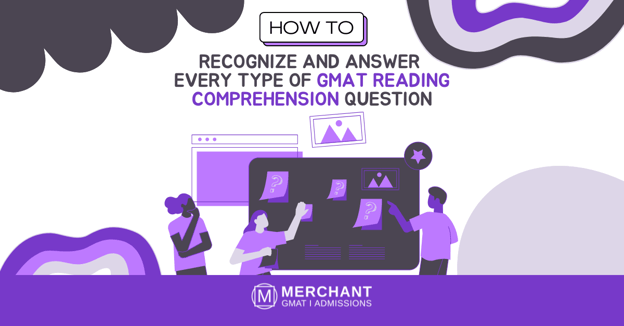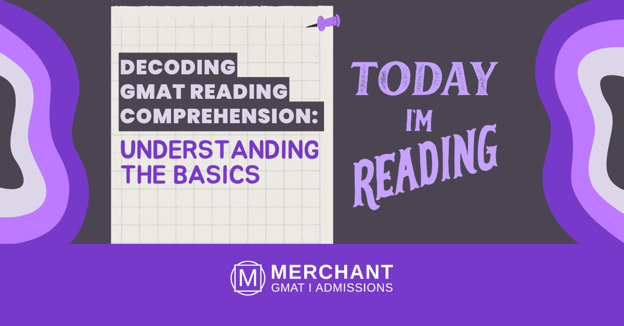Read for Structure: Our Reading Comprehension Guide

As you dive into your verbal GMAT training, you may notice that Reading Comprehension (RC) is one of the most challenging sections in the exam. I can’t stress enough how important it is for students to learn how to properly target this section and avoid severely damaging their scores. To make sure you stay away from such pitfalls we wanted to create this Reading Comprehension Guide.
First of all, it involves grasping a clear understanding of a brief text in very little time. Usually, these texts are either about a well-known subject for the reader (e.g: business or economics) or something extremely unfamiliar (e.g: geology or astronomy). The first one tries to trick you into feeling you already know this and the second one attempts to scare you off by discussing a very hard topic with unusual words or expressions.
Moreover, should you fail to properly analyze the text, then you would probably get many answer choices wrong in a row as they are all about the same text and you do not have enough time for re-reading it many times.
However, you should not panic about this section. Below is an explanation on how to rock these problems, which can help to improve your score significantly.
Reading Comprehension Strategy
Any RC question starts with reading the text, but here comes our first recommendation: Be passionate about what you’re going to read! Even if you’ve always hated economic history, for the next few minutes, this will become the most interesting text you have ever read.
Moreover, you should read for structure. What does this mean? It means that you should be noticing several things as you read:
- Which voices do you notice in the text? Is the author writing an opinion essay where only his views are present or is he also mentioning what other people believe or have said?
- How is the text organized? What is the purpose of each paragraph in the text? Is the paragraph describing the current situation or is it about making a point about that situation?
- Look for alert words. Just like in Critical Reasoning, words like “however”, “moreover” or “thus” can help you understand how the text is flowing.
Developing these skills requires practice. To help you with it, we will be analyzing an official guide problem next. If you want to give it a try on your own first, then click on the link below and then come back here for the step-by-step explanation.
GMAT Club – The Great Depression in Latin America
The Great Depression in Latin America
During the 1980s, many economic historians
studying Latin America focused on the impact of
the Great Depression of the 1930s. Most of these
historians argued that although the Depression
(5)
began earlier in Latin America than in the United
States, it was less severe in Latin America and did
not significantly impede industrial growth there.
SO FAR, THE AUTHOR IS ONLY DESCRIBING WHAT THESE ECONOMIC HISTORIANS FROM 1980 ARGUED. DOES HE AGREE WITH THIS? HAS IT CHANGED? THESE COULD BE QUESTIONS THAT MAY BE ANSWERED AS THIS TEXT PROGRESSES.
The historians’ argument was grounded in national
government records concerning tax revenues and
(10)
exports and in government-sponsored industrial
censuses, from which historians have drawn
conclusions about total manufacturing output
and profit levels across Latin America.
VERY IMPORTANT TO NOTICE THAT THE AUTHOR KEEPS TALKING ABOUT THE HISTORIANS’ ARGUMENT, NOT HIS. NOW WE ALSO KNOW WHAT THIS ARGUMENT WAS BASED ON. IS HE GOING TO CHALLENGE IT?
However, ALERT WORD – HE MIGHT CHALLENGE THIS VIEW.
economic statistics published by Latin American
(15)
governments in the early twentieth century are
neither reliable nor consistent;
OKAY, SO THE AUTHOR IS AT THE VERY LEAST RAISING SOME DOUBT ABOUT THIS HISTORIAN’S VIEW: “STATISTICS … ARE NEITHER RELIABLE NOR CONSISTENT”.
this is especially
true of manufacturing data, which were gathered
from factory owners for taxation purposes and
which therefore may well be distorted.
AUTHOR’S FIRST ARGUMENT TO SUPPORT HIS PREVIOUS STATEMENT.
Moreover, ALERT WORD – ADDITIONAL SUPPORTING INFORMATION PROBABLY
(20)
one cannot assume a direct correlation between
the output level and the profit level of a given
industry as these variables often move in opposite
directions.
YES, THAT WAS THE SECOND SUPPORTING ARGUMENT.
Finally, ALERT WORD – PROBABLY HIS FINAL SUPPORTING ARGUMENT
national and regional economies
are composed of individual firms and industries,
(25)
and relying on general, sweeping economic
indicators may mask substantial variations among
these different enterprises. For example, recent
analyses of previously unexamined data on textile
manufacturing in Brazil and Mexico suggest that the
(30)
Great Depression had a more severe impact on this
Latin American industry than scholars
had recognized.
FINAL SUPPORTING ARGUMENT GIVEN + AN EXAMPLE.
It’s very important to remember to read for structure like we just did as you should now have a clear summary of this text:
- 1980’s historians argued that the Great Depression was less severe in Latin America than in the USA and did not impede industrial growth.
- This view was based on tax/exports records + government-sponsored industrial censuses.
- However, the author mentions this info is not reliable/consistent for 3 reasons.
- Manufacturing data was gathered from owners for taxation purposes 🡪 could be inaccurate.
- Historians assuming correlation between output and profit, may be a mistake. They often move in opposite directions.
- General indicators may not tell the whole story like the example given about textiles in Brazil and Mexico.
This analysis shouldn’t take you more than 1-2 minutes. Now we can tackle the questions.
Question 1: The primary purpose of the passage is to:
PURPOSE QUESTION – WE WILL NOT SPECIFICALLY FIND THE ANSWER IN THE TEXT. FOR EACH ANSWER, THINK WHETHER THAT IS THE NUMBER ONE, MAIN REASON WHY THE AUTHOR DECIDED TO WRITE THIS PASSAGE. MAKE SURE YOU AGREE WITH EVERY PART OF THE ANSWER CHOICE. IF NO, ELIMINATE.
- compare the impact of the Great Depression on Latin America with its impact on the United States – INCORRECT. WE KNOW NOTHING ABOUT HOW ONE COMPARES TO THE OTHER BASED ON THIS TEXT.
- criticize a school of economic historians for failing to analyze the Great Depression in Latin America within a global context – GLOBAL CONTEXT? NOT MENTIONED IN THE TEXT. THE AUTHOR CRITICIZES THE SOURCES OF INFORMATION INSTEAD.
- illustrate the risks inherent in comparing different types of economic enterprises to explain economic phenomena – FALSE. NOT AT ALL THE POINT OF THE TEXT.
- call into question certain scholars’ views concerning the severity of the Great Depression in Latin America – CORRECT, THIS WAS THE AUTHOR’S POINT EXACTLY.
- demonstrate that the Great Depression had a more severe impact on industry in Latin America than in certain other regions – FALSE, THE AUTHOR DIDN’T COMPARE ANYTHING.
Question 2: Which of the following conclusions about the Great Depression is best supported by the passage?
INFERENCE QUESTION – CAN YOU REASONABLY INFER THIS BASED ON THE INFORMATION THAT YOU FOUND IN THE PASSAGE? IF NO, ELIMINATE.
- It did not impede Latin American industrial growth as much as historians had previously thought. – WE DON’T KNOW. WE JUST KNOW THAT THE SOURCES OF INFORMATION WERE FLAWED.
It had a more severe impact on the Brazilian and the Mexican textile industries than it had on Latin America as a region. – NOT PRESENT IN THE TEXT. - It affected the Latin American textile industry more severely than it did any other industry in Latin America. NOT PRESENT IN THE TEXT.
- The overall impact on Latin American industrial growth should be reevaluated by economic historians. TRUE – THAT IS THE AUTHORS POINT. IT SHOULD BE REASSESED, BUT WE DON’T KNOW WHETHER IT WILL CHANGE THE VIEW OR NOT.
- Its impact on Latin America should not be compared with its impact on the United States – NOT SAYING THIS AT ALL.
Question 3: Which of the following, if true, would most strengthen the author’s assertion regarding economic indicators in lines 25–27?
STRENGTHENING TYPE. LOOK FOR THE AUTHOR’S ASSERTION IN THESE LINES (“… national and regional economies are composed of individual firms and industries and relying on general indicators … may mask substantial variations among different enterprises”). WHAT WOULD STRENGTHEN IT MOST?
- During an economic depression, European textile manufacturers’ profits rise while their industrial output remains steady. – NO DIFFERENCES BETWEEN ENTERPRISES/INDIVIDUALS. ONLY ABOUT TEXTILES. DOES NOT STRENGTHEN IT.
- During a national economic recession, United States microchips manufacturers’ profits rise sharply while United States steel manufacturers’ profits plunge. – CORRECT, THIS IS EXACTLY WHAT THE AUTHOR IS SAYING. DURING THE RECESSION, MICROCHIPS INCREASED AND STEEL PLUNGED, BUT IT STILL IS A NATIONAL RECESSION (ECONOMY FELL AS A WHOLE).
- During the years following a severe economic depression, textile manufacturers’ output levels and profit levels increase in Brazil and Mexico but not in the rest of Latin America. – ONLY CONSIDERING TEXTILE MANUFACTURERS, WRONG.
- Although Japanese industry as a whole recovers after an economic recession, it does not regain its previously high levels of production – NOT STRENGTHENING THE AUTHOR’S POINT ABOUT GENERAL INDICATORS MASKING DIFFERENT VARIATIONS. WRONG.
- While European industrial output increases in the years following an economic depression, total output remains below that of Japan or the United States – NOT STRENGTHENING THE AUTHOR’S POINT ABOUT GENERAL INDICATORS MASKING DIFFERENT VARIATIONS. WRONG.
This way of analyzing RC questions may look tough at the beginning, but after some practice, it becomes part of your routine. Moreover, it will also boost your ability to understand CR or even quant problems. Furthermore, this is a valuable skill for both work and everyday life. It will definitely improve the way you understand a text. Let’s get to work!
Written by Verbal Coach Agustin Artero
If you need help with the GMAT or the admissions process we can help. For more information on our different GMAT products see:
- GMAT private classes – see the stories of Will, Teddy, Jessica and Nico and how they approached their GMAT journey with Merchant.
- Merchant Academy – a GMAT teaching innovation that makes taking the GMAT, like an MBA. Click to find out more about the Merchant Academy format.
- Merchant GMAT Hall of Fame – a gallery of some of our clients over the last eight years.
For admissions help see some of the client stories on our admissions page.
Ready to Start?
Fill out the form, and a member of the Merchant Sales Team will be in contact with you shortly to discuss your MBA journey





